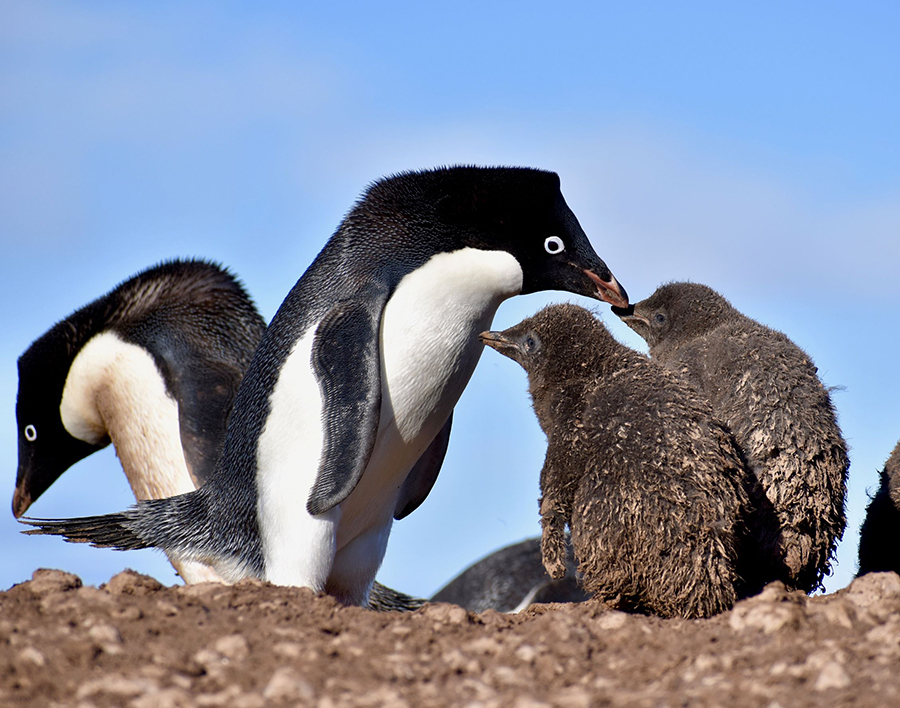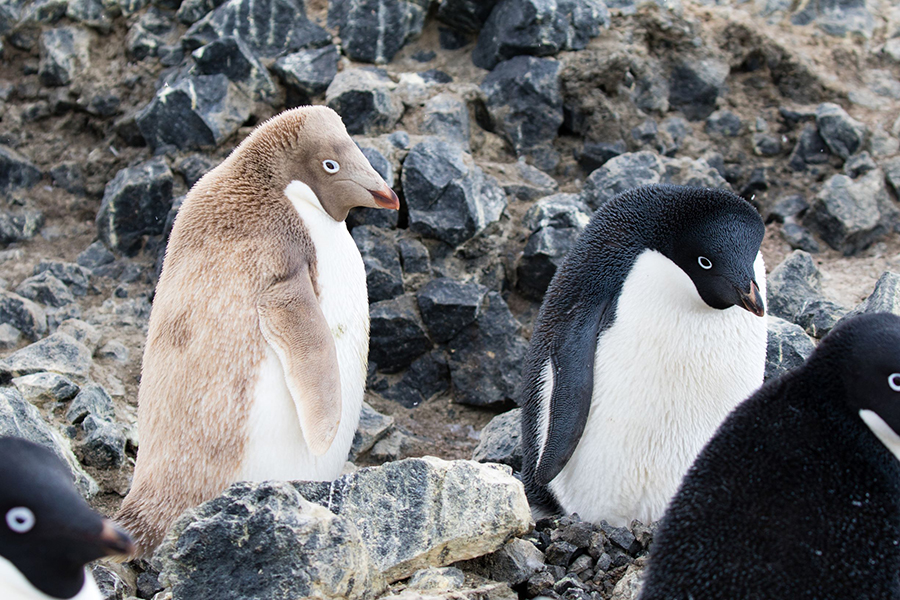Meet the penguin misfitsNew research shows these rare off-color penguins still find mates (usually)Posted September 07, 2021
Looks are important for Adélie penguins, but they may not be as critical for breeding as biologists previously thought. New research shows Adélie penguins with unusual coloring still manage to breed successfully, contrary to what biologists had predicted. Scientists observing a large colony of Adélie penguins in Antarctica found these rare penguin ‘misfits' find mates just as often as their black-and-white-colored counterparts. There are only a handful of off-color penguins in the colony, so the researchers cannot draw definitive conclusions, but their results suggest penguin coloring may not be as important for major life activities as biologists previously suspected. 
Photo Credit: Lauren Lipuma
Some of the penguin misfits seen at Cape Crozier from October 2019 to January 2020.
"We found that they bred at similar rates, and they were just as successful as normal-colored penguins," said Parker Levinson, a graduate student at Montana State University and lead author of a recent study detailing the findings. Adélie penguins breed only in Antarctica and are an important indicator species of climate change. They depend on sea ice to survive the winter months, but sea ice is declining as the climate warms. They also need dry land to make nests in early spring, so additional snow brought on by climate change hampers their ability to lay eggs. Gaining more knowledge about what affects these penguins' reproduction and survival may help biologists predict how the charismatic animals will fare in the coming decades. "As Antarctica unfortunately warms, they might face different foraging conditions, and maybe these individuals will hold different advantages," Levinson said. "We want to document now what their breeding frequency is, and have that somewhere in the record, so we can compare it later on." Coats of (not so) many colorsPlumage color variation occasionally occurs in birds, but it is rare – especially in penguins. Biologists suspect this is because penguins' iconic tuxedo-style coloring lets them blend into their surroundings while foraging for food in the ocean. Their black backs allow them to blend into the shadows of the depths if a predator spots them from above, while their white bellies let them blend into light waters if a predator looks up from below. Color is also important for certain penguin species in their other key life activity: finding a mate. The yellow and orange accents on king penguins tend to signify the overall health of the animal, and biologists have noticed that females are often drawn to color when they select mates. Females tend to pick males with larger color patches, and males have a harder time pairing off when their bright color accents are obscured or covered up. Biologists suspected Adélie penguins might also use visual cues when choosing mates, but little research had been done on the subject. "There's not a lot of knowledge right now about how Adélie penguins choose their mates, and there was some thought that they could use visual cues," Levinson said. "They would see these penguins and they would be like, ‘Oh, you don't look like the other penguins. We don't want to breed with you.' So we thought maybe they wouldn't show the same fitness as a normal-color penguin." Off-color Adélie penguins have been seen in Antarctica since the time of the early explorers, but these animals are rare. Biologists have been studying a large colony of penguins at Cape Crozier, on Antarctica's Ross Island, for many years. They've recorded numerous sightings of unusual penguins over the years, but no one had taken a close look at the off-color individuals' breeding behavior. During the 2019-2020 austral summer, Levinson decided to track the penguin misfits throughout their breeding season and see if they were as successful at finding mates as their normal-colored friends. She and her colleagues at Cape Crozier searched the whole colony regularly, recording any unusual penguins. After marking the penguins' territories, Levinson checked in on them every few days, noting whether they were alone or with a mate. And if they did have a mate, if the couple had any chicks. "Initially we thought that because they didn't have the traditional coloring, they wouldn't breed as often and they wouldn't breed as successfully," Levinson said. Mates and chicksThe Adélie penguin colony at Cape Crozier is one of the largest in the world, with more than 300,000 breeding pairs making it their home. But the researchers identified only 12 individuals without the typical tuxedo coloring. 
Photo Credit: Parker Levinson
Penguins normally have black-and-white countershading to help them blend in while foraging for food in the ocean. This photo shows a normal-colored penguin with two downy chicks who haven't yet developed their tuxedo-style coloring.
They saw seven dark brown penguins, one light brown individual, three penguins with progressive graying (meaning their black feathers were slowly transitioning to white), and one "dilute" or gray penguin. As Levinson and her team tracked the off-color penguins from October 2019 to January 2020, they saw that the misfits bred just as often as individuals with standard black-and-white coloring. Levinson found six of the off-color penguins bred with a normal-colored mate and five of those raised chicks with their partner. Interestingly, none of the misfits paired up and bred with one another. One of the female dark brown penguins who bred and had a chick was first seen in 2011 in the same territory. Researchers know she has raised at least one other chick, so her unusual coloring doesn't seem to have stifled her long-term ability to survive and reproduce. The researchers also tracked a sample of normal-colored penguins in the colony as a comparison. They found the normal-colored individuals bred at a similar rate, meaning the misfit penguins were just as successful at finding mates and raising chicks as their black-and-white counterparts. The chicks of off-color and normal-colored couples seemed to have normal chick plumage, but the researchers don't know what the chicks' plumage looked like as they grew into adults. Color and survivalThe results suggest Adélie penguins may not use color in the way other species do when selecting mates – or at least not in the way biologists thought. But with such a small sample size, the researchers can't say it applies to all penguin colonies. "Adélie penguins maybe aren't using visual cues as much to find a mate; they could be looking more at behavioral cues," Levinson said. "There might be some sort of level of color aberration that is tolerable for penguins. It doesn't strike them as abnormal, or they sort of blend in." There were, however, some exceptions. One gray penguin, affectionately called Platinum, has been seen at Cape Crozier since 2009. To biologists' knowledge, he has never found a mate or raised a chick. However, it's hard to say if this lack of breeding success is related to Platinum's coloring or something else. Levinson confessed she inevitably became attached to the odd-colored individuals. "As a wildlife biologist, you're not supposed to get really attached to your study of species and animals, but it was nice to be able to have a little bit more of a connection with these penguins," she said. This research is supported by the National Science Foundation, which manages the U.S. Antarctic Program. NSF-funded research in this story: Grant Ballard, Point Reyes Bird Observatory, Award No. 1543498 and Award No. 1834986. |



For USAP Participants |
For The Public |
For Researchers and EducatorsContact UsU.S. National Science FoundationOffice of Polar Programs Geosciences Directorate 2415 Eisenhower Avenue, Suite W7100 Alexandria, VA 22314 Sign up for the NSF Office of Polar Programs newsletter and events. Feedback Form |


